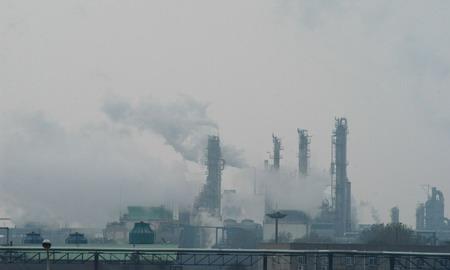
This picture taken in December 2007 shows Celanese's chemical facility in Nanjing, in East China's Jiangsu province. It is the American chemical company's largest single investment in China to date. The facility is engaged in the production of acetic acid and other chemical products. [Yang Guang / China Foto press]
Acetyl manufacturer sets itself strict targets on energy use and gas emissionsBEIJING - Mark Oberle, senior vice-president, corporate affairs, of US chemical company Celanese, has no doubts about his company's targets over the next five years.
As one of the world's largest producers of acetyl products, Celanese in May announced its five-year environmental, health and safety (EHS) goals for the areas of occupational safety performance, energy intensity, greenhouse gases and waste management for the year of 2015. It was a move to strengthen its efforts in safe operational measures and environmental protection while maintaining strong economic growth.
With this in mind, Celanese committed itself to reduce its energy use by 20 percent over the next five years, decrease greenhouse gas emissions and waste by 20 percent and 25 percent in the same period, as well as reduce its Occupational Safety and Health Act incident rate to 0.07, down by 70 percent from its current level.
"We are now well on track to meet or exceed the environmental intensity goals we set for year 2010," said Oberle. The company in 2005 made targets to reduce its energy use by 20 percent in five years, greenhouse gas emissions by 30 percent and waste by 40 percent.
As a chemicals producer, Celanese focuses on issues including safety, energy saving and environmental protection to achieve sustainability, said Oberle, adding that there was no exception for the Chinese market.
"Celanese is a heavily invested and involved member of the Chinese community, and we are proactively engaging with government officials and other chemical companies to promote responsible safety and environmental practices," said Oberle.
In 2009, Celanese sponsored a process safety symposium in conjunction with the China Petroleum and Chemical Industry Association (CPCIA). The goal was to explain the philosophies of process safety, share how Celanese manages its safety programs, and raise awareness of how to avoid catastrophic injury or loss of facilities.
A key message of the event was that the industry, government and companies were all responsible for process safety and must work together to make process safety improvements. This symposium was such a success that Celanese is again cosponsoring a process safety symposium in September 2010.
In 2005, Celanese launched its "Journey to Zero" safety program. Today, a large majority of the company's manufacturing sites have gone several years without a lost-time injury, and more than 70 percent of the company's facilities have gone without a serious injury incident in the past year.
"Regardless of where Celanese does business, we follow the same stringent procedures for process, occupational and environmental safety. That means our employees and neighbors in China are as safe as our employees and the communities in or near our other plants throughout the world," said Oberle.
"Celanese will continue to work toward greater awareness and understanding about the value of process safety in China and in other locations where we do business."
Environmental care
 Mark Oberle
Mark Oberle At present the largest single investment of Celanese in China is an integrated chemical facility in Nanjing, Jiangsu province, which is used to produce acetic acid and other chemical products.
The complex, which began operations in 2007, has used some of the company's most advanced technologies. As a result, it can save more energy and make less pollution compared with conventional facilities, said Oberle.
For instance, compared with the company's Pampa plant in the US, the Nanjing site has more than five times lower greenhouse gas emissions and releases 12 times less lower volatile organic compounds, in addition to using over ten times less energy to produce the same amount of product.
Celanese now has a global, cross-functional team to seek new process improvements, technologies and other enhancements that will significantly reduce energy consumption and greenhouse gas emissions. The team also encourages input from Celanese workers worldwide, challenging them to analyze and suggest improvements, said Oberle.
"We are on a journey to fulfill our promise to use less energy, cut waste, and reduce air emissions and water use," he said.
The company's efforts in environmental protection are also in line with the development of China's chemical industry, added Oberle. According to CPCIA, energy saving and environmental protection will be two focuses of China's petrochemical industry in the 12th five-year (2011-2015) period.
In terms of product structure, production of all petrochemical products should be more environmentally friendly. Some high-end chemical products such as engineering plastics should rely less on imports, according to CPCIA.
International chemicals giants, which have advanced technologies, can play increasingly important roles in upgrading China's chemical industry, said Li Yongwu, head of CPCIA. Forty percent of Celanese's economic activities are now in the Asia-Pacific region, and 20 percent are in China, said Oberle.
It will certainly see some increase in these figures over the next few years, he added.
In 2007, Celanese relocated the strategic management of its acetyl business to Shanghai to manage its global business functions as well as to bear overall responsibility for Asia.






